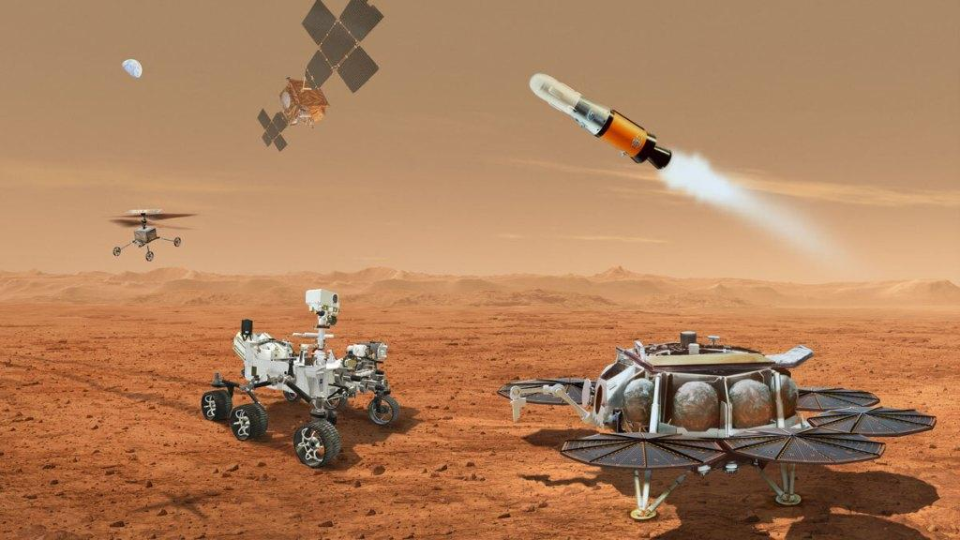
During the week of March 10, the Planetary Science community gathered in The Woodlands, Texas, a suburb of Houston – and also in Zoom – as we watched dozens and dozens of presentations on everything from tomorrow’s planned missions to today’s latest research results. I was one of the many folks on Zoom, so I was missing the between-sessions gossip, but I can bring you the science. And since the panels are all still up for attendees to rewatch to their hearts’ delight, this may be a multi-week review of what all I have learned and will be learning.
My personal starting point was Mars. Special Sessions focused on Perseverance over in Jezero Crater and Curiosity in Gale Crater.
Percy, originally called Mars 2020, launched July 30 2020 and arrived on Mars in February 2021. A pandemic baby, this mission has over and over proven that researchers can and will work from anywhere via any means necessary, to get their research done. This mission was meant to be part one of two.
As it roves through the river delta that sprawls across Jezero Crater, Perseverance is collecting rock and mineral samples, in 43 different sample tubes. 10 samples have been cached along the way, three samples will be kept on the rover in perpetuity as references, and ideally, 30 samples will be returned to Earth.
At least in theory.
The Mars Sample Return mission is not slated to launch this decade, and in all likelihood, we can’t expect samples to be returned any earlier than the mid-2030s.
For those of you now thinking, “But SpaceX plans to launch humans to Mars by 2030, I’d like to point out that Starship hasn’t met any of the required milestones for going to the Moon, and it was supposed to have made its first landing 2 years ago. Based on past performance and lack of needed technology to maintain humans on a multiyear mission, experts don’t anticipate humans to leave for Mars this decade, and the next decade is looking to be a challenge as well. As much as it’s intriguing to imagine humans walking up to Percy to collect his samples for return to Earth, that isn’t something likely to happen anytime soon, and researchers hold out hope for a robot mission making the round trip as a test of the technology that will be required to bring humans back from Mars.
With Percy’s mission still going strong, and no hurry to fill up sample tubes in anticipation of a soon-to-arrive Sample Return mission, researchers are now very carefully selecting what samples are sample tube-worthy. Helping with that selection process is the SHERLOC instrument, which can abrade rocks to reveal the surface and then do multispectral measurements to understand what the rocks are made of. Working in partnership with the WATSON instrument, a Wide Angle Topographic Sensor, researchers are able to look at the context of different rocks, and then zoom in to see minerals in detail. While not equipped to identify life, they can identify organic compounds – the stuff necessary for life as we know it. And they are finding lots of organics to tantalize folks lik e me with a hope that someday we’ll find fossilized life – however tiny – in the sedimentary layers of Mars surface.
But it hasn’t all been going entirely smoothly. SHERLOC’s motor had a very bad moment last summer when its motor got jammed with the dust cover closed. Team researchers were able to get the dust cover open, but they lost their ability to autofocus along the way.
Now, to focus SHERLOC, they actually move the entire camera back and forth until things are most in focus… and the way they figure out if things are in focus is super clever. The way modern image compression works, images are larger the more detail they contain. Since unfocused images will be a fairly monotone smear and in-focus images will be much more detailed, they will place the camera about four centimeters away from what they are imaging and move it in and out ever so slightly to figure out where they see the maximum file size. This is computationally simple and I really love the simplicity of this solution.
Looking ahead, NASA did an entire special session on the future of Mars exploration. As a reminder for those of you who track these things, there are low-energy launch windows to Mars in late 2026 and over Christmas and New Years in 2028-2029. The US doesn’t have specific missions planned for either of these windows, but we are collaborating with ESA on the Rosalind Franklin Lander, which will go up at the end of this decade, and the private US company Relativity Space will be launching a mission at the end of next year. Our next big Mars effort will be the as-yet unscheduled and unselected Mars Sample Return mission.
